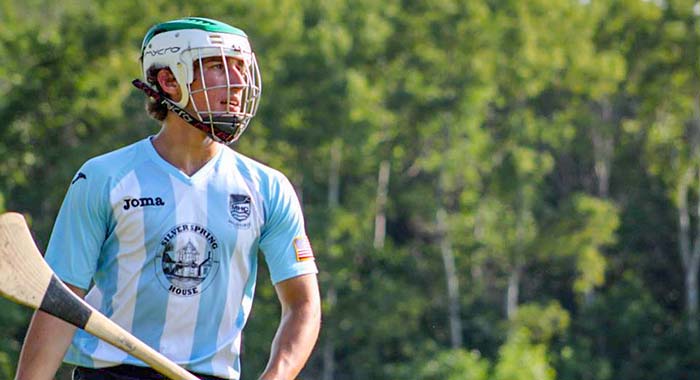St. Norbert’s Only Hurler Joins the World’s Best at the Gaelic Games
Colin Zuelzke ’17 has played a variety of sports – soccer, tennis, baseball. He enjoys snowboarding, but his favorite athletic pastime is hurling, a team game of Gaelic roots that was first played more than 3,000 years ago.“It’s the fastest sport on grass,” says Zuelzke. “It’s unlike anything I’ve ever played. I like the speed of the game. There’s always action.”
Teams of 15 players compete on a field approximately 140 meters long and 100 meters wide. Players use a hurley, a curved wooden stick made of ash, to move a small ball, called a sliothar (pronounced “slitter”), down the field. Three points are scored for hitting the ball through a goal and one point is awarded for sending the ball through the uprights.
Positions on the field include full forward, half forward, halfback, fullback and midfield, the position that Zuelzke plays as part of the Milwaukee Hurling Club.
“When playing midfield, you are a transitional player to get the offense going,” he explains. “You decide where the ball is going, whether you want to send it to the half forward line or full forward line. You also have to play some defense. I don’t score much being a midfielder, but if I score points, I enjoy it.”
Hurlers may advance the ball by balancing it on the end of the stick, striking the ball in the air or on the ground with the stick, kicking the ball or slapping it with an open hand.
“Balancing it on your stick takes a lot of practice and hand-eye coordination,” says Zuelzke. “We get a lot of hockey and lacrosse players that join our sport and they say that hurling helps with their stick-handling skills.”
Zuelzke started playing the game four years ago. His stepbrother, Jesse Rapkin, invited him to practice.
“I was hooked immediately,” he says.
Zuelzke appreciates the history of the sport.
“It’s pretty cool how it’s still around and is pretty similar to the original game,” he says. “It’s the national sport of Ireland, so that’s all they do. They grow up playing it. The Irish players have great folk stories of legends and heroes that played the game. I participated in the North American GAA (Gaelic Games) in Boston over Labor Day weekend. Several of the clubs there from around the country recruit players from Ireland. They are unbelievable. They are born playing the game.”
The only protective gear required for this contact sport is a helmet. Zuelzke’s helmet and sticks were made in Dublin. The grip used on the stick differs from baseball.
“I’m a lefty, so my left hand is on the bottom,” he explains. “It’s more of a wrist motion where baseball is an entire body twisting.”
The hurling season mainly covers the summer months. Zuelzke works out to stay in shape in the offseason. He tries to keep his skills sharp by hitting the ball against a racquetball court wall.
“Unfortunately, I’m the only hurling player on campus,” he says. “When I tell people here that I play hurling, they often say ‘curling?’ They don’t know what it is.”
When Zuelzke finishes his education, he hopes to find a position in a city that has a hurling club. His goal is to play in Ireland someday.
“I would love to go there,” he says. “Our club was given the opportunity, one of 16 in the world, to play in Ireland last year. I didn’t make the cut, so I didn’t go. If there’s another opportunity, I will make it for sure this time.”
Oct. 7, 2014












